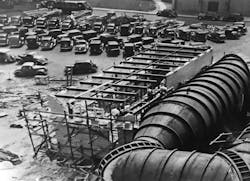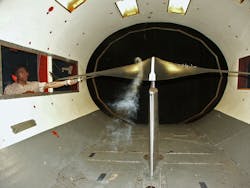MIT Upgrades the Wright Brothers Wind Tunnel
For 79 years, the Wright Brothers Wind Tunnel at Massachusetts Institute of Technology has been a mainstay of the institution, serving as a home for aviation innovation and product testing. This month, MIT announced plans to replace the wind tunnel with a newer, larger facility, making it the largest academic wind tunnel in the United States.
The original wind tunnel was dedicated in 1938. It served as a design and testing center for military aircraft during the early days of World War II. Over the years the tunnel has been used to test a variety of products, including ground antenna configurations; aircraft and ground structure aero-elasticity; ski gear; space suits; bicycles; motorcycles; subway station entrances; ship sails; wind turbines; solar cars; and new clean, quiet, and efficient commercial aircrafts.
The new Wright Brothers Wind Tunnel will bring a much needed update to the test facility, which has been in operation since 1938. Building 17, which is located to the right of the tunnel and contains its controls, will also receive a new structure added to the rear for an elevator and access bridge to AeroAstro’s Neumann Hangar. (Image courtesy of Imai Keller Moore Architects, MIT)
After eight decades of operation, the tunnel is in need of repair. The drive system used is inefficient and the structure and adjacent controls require renovations and modernizations. “The new Wright Brothers Wind Tunnel will present MIT with a state-of-the-art research and teaching tool for many years to come,” says Jaime Peraire, head of the Department of Aeronautics and Astronautics (AeroAstro). The tunnel is used by several MIT departments for testing and has been used by several current Boeing employees who are MIT alumni. Boeing is the project lead donor, pledging $18 million to the project. Boeing currently employs more than 800 MIT graduates.
The original wind tunnel at MIT was used during the early days of World War II for military aircraft development. (Photo courtesy of MIT Museum)
The new tunnel will be constructed on the same site as the current one and will retain the Wright Brothers name. It will be operated by AeroAstro and will institute the following improvements:
- Permit increased test speeds, raising the current 150-miles-per-hour limit to 200 miles per hour
- Improve research data acquisition with new data collection sensors and methods
- Reduce the power requirements by half of the original 2,000 horsepower fan motor
- Increase test section volume from 850 cubic ft. to 1,600 cubic ft., and test section area from 57 sq. ft. to 80 sq. ft.
- Improve the ability to test autonomous vehicles such as drones and aerodynamic components, including wings, bodies, and wind turbines
Boeing is the project’s lead donor at $18 million. Several of Boeing’s current employers are MIT graduates, demonstrating the strong connection MIT and Boeing have with one another. (Photo courtesy of William Litant, MIT)
Renovations will also take place to MIT Building 17, which houses the control facilities and direct connection made to the workshops. The entire project is expected to be completed by 2020.




